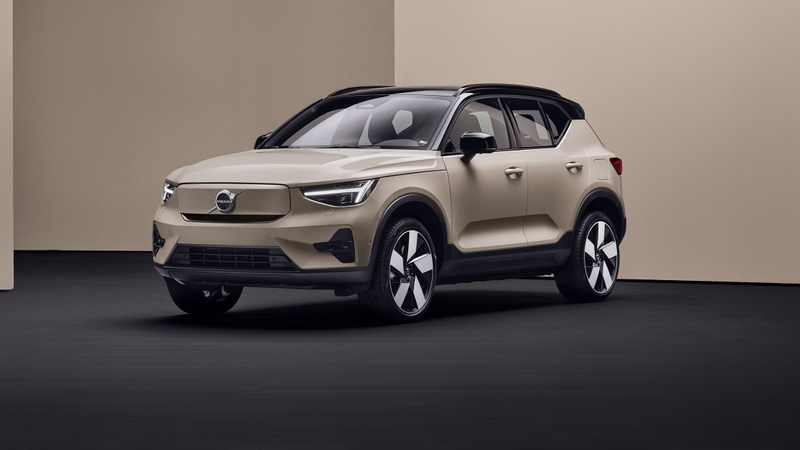
Volvo XC40 interior, tech and practicality
Gallery
Comfort and visibility
Like all modern Volvos, the XC40 has a neatly designed interior that centres around a portrait touchscreen. Its clean lines are completely different to the angled dashboard of the Audi Q3, and the whole interior is calm and sophisticated.
That feeling of sophistication continues with some of the materials – the air vent controls and door handles feel metallic and solid, the leather on the steering wheel is soft and smooth, and there are some soft-touch surfaces. But you’ll also find some cheaper materials, such as the lower centre console plastic and parts of the door trim.
Having the touchscreen plumbed into the dashboard has worked out well – it’s close enough to your eyeline so you don’t have to look away from the road for too long, but low down enough not to impede on forward visibility. Over-the-shoulder visibility is also okay, but the XC40’s chunky rear pillars make it a little tricky to see where you’ve been. At least rear parking sensors are fitted as standard.
Standard equipment
At launch, the XC40’s entry-level trim was Momentum. This includes cruise control, keyless start, automatic LED headlights with high-beam assist, 18-inch alloy wheels, two-zone climate control and a host of safety assistance including auto emergency braking.
R-Design is Volvo’s sporty-looking trim, similar to Audi’s S Line and BMW’s M Sport trims. So you get the usual assortment of glossy black trim, black headlining, metal-effect pedals and tinted rear windows – plus under-knee cushion extenders, ambient lighting, tailgate lighting and LED foglights.
Inscription is more luxury-focused, with a powered tailgate, chrome trim, a powered driver’s seat, front parking sensors and even a crystal gear lever on automatic versions.
Look out for the ‘Pro’ versions of each of these trim levels for heated front seats, a heated windscreen, heated washer nozzles and adaptive bending headlights.
As the name suggests, First Edition was a launch model available early in the XC40’s lifespan, which came fully equipped. On top of R-Design Pro, the First Edition gets a powered tailgate and passenger seat, wireless phone charging, laminated windows, adaptive cruise control, automated parking assistance and a panoramic sunroof.
Newer cars come in Core, Plus and Ultimate trim levels, which essentially replace the previous trim levels respectively. They’re slightly better equipped than the previous ones – Core now comes with a reversing camera and a powered tailgate. Plus adds a 360-degree camera and heated rear seats, while Ultimate gets a pano sunroof, a Harman Kardon sound system and even more upgraded headlights.
Infotainment and audio
When the Volvo XC40 was launched, the nine-inch portrait touchscreen seemed large and cutting-edge. Fast-forward a few years and most rivals now have more screen real estate and sharper graphics, but Volvo’s system still works pretty well and is decent in isolation.
The main functions are arranged in a stack, with each section big enough that it’s easy to hit the area you want while driving. We’re usually not keen on the climate controls being wrapped up in the screen, but here the response is good enough that it’s not really an issue. Some submenus could be easier to find but, once you’ve lived with the car for a few days, you’ll remember how to get to where you want.
Wired Apple CarPlay was available from 2019, although a dealer can add this feature onto cars that didn’t come with it as standard for extra cost. Android Auto isn’t provided, but newer XC40s use a Google operating system that has built-in Google Maps.
Rear seat space
The majority of passengers will be able to stretch out and get comfortable in the back of the XC40. Unless two tall adults are sitting one behind the other, there’s plenty of legroom and space to slide your feet under the front seats. Headroom is also really good, thanks to the car’s boxy shape. Mind you, a BMW X1 is more spacious still in the back.
You’ll struggle to get three across the back row in the XC40. There’s a big transmission tunnel that robs foot room, the front central armrest takes up a lot of middle-seat legroom, and the seat itself isn’t shaped to be comfortable. Best to use it only for short journeys, or treat the XC40 as a four-seater and enjoy the extra cupholders in the flip-down rear armrest.
Rear-seat passengers are pretty well treated, with soft-touch elbow rests, seatback pockets, air vents and USB-C connections. The door bins are massive and are fabric-lined to stop items rattling around.
Boot space
Like the car’s styling, the boot space is almost exactly square. It’s a really useful space that’ll easily swallow a big pushchair or several suitcases, even if the actual size of the boot – 452 litres – is about 10% smaller than the likes of the BMW X1 and Audi Q3. You also get a couple of tiedowns, hooks and side pockets, and some cars get a useful elastic strap to stop your Abba memorabilia flying across the boot.
Electric XC40s get the same boot space as petrol and diesel ones, while the swoopy coupe-styled C40 only loses around 40 litres compared to the XC40.
Elsewhere, storage space is pretty good. The average-sized glovebox is made up for with massive door bins and lots of shallow central storage areas.


























































